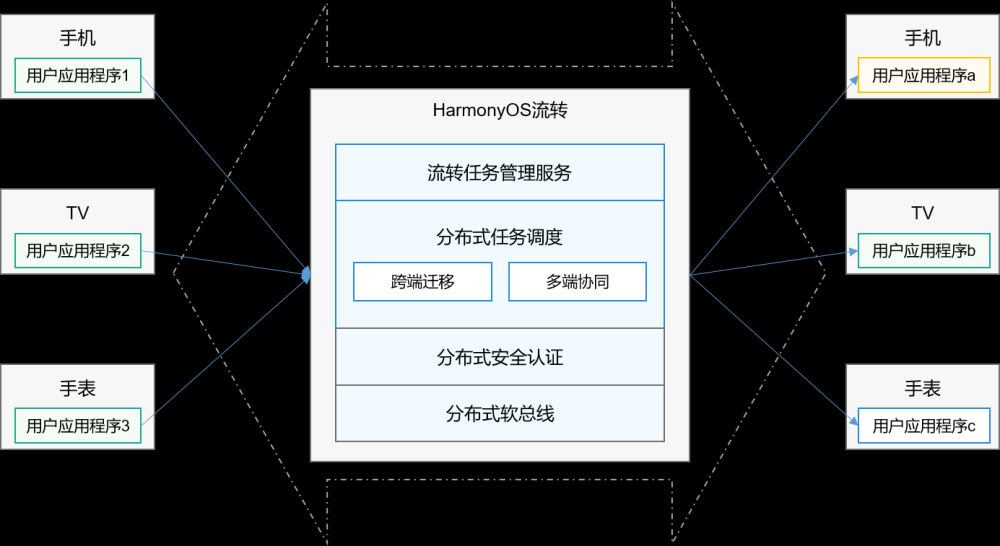TableLayout
TableLayout使用表格的方式划分子组件。

支持的XML属性
TableLayout的共有XML属性继承自:Component
TableLayout的自有XML属性见下表:
| 属性名称 |
中文描述 |
取值 |
取值说明 |
使用案例 |
|---|---|---|---|---|
| alignment_type |
对齐方式 |
align_edges |
表示TableLayout内的组件按边界对齐。 |
ohos:alignment_type="align_edges" |
| align_contents |
表示TableLayout内的组件按边距对齐。 |
ohos:alignment_type="align_contents" |
||
| column_count |
列数 |
integer类型 |
可以直接设置整型数值,也可以引用integer资源。 |
ohos:column_count="3" ohos:column_count="$integer:count" |
| row_count |
行数 |
integer类型 |
可以直接设置整型数值,也可以引用integer资源。 |
ohos:row_count="2" ohos:row_count="$integer:count" |
| orientation |
排列方向 |
horizontal |
表示水平方向布局。 |
ohos:orientation="horizontal" |
| vertical |
表示垂直方向布局。 |
ohos:orientation="vertical" |
TableLayout的创建
- 在XML中创建TableLayout,示例代码如下:
<?xml version="1.0" encoding="utf-8"?>
<TableLayout
xmlns:ohos="http://schemas.huawei.com/res/ohos"
ohos:height="match_parent"
ohos:width="match_parent"
ohos:background_element="#87CEEB"
ohos:padding="8vp">
</TableLayout>- 添加子组件
a.在graphic文件夹下创建Text的背景table_text_bg_element.xml,示例代码如下
<?xml version="1.0" encoding="utf-8"?>
<shape xmlns:ohos="http://schemas.huawei.com/res/ohos"
ohos:shape="rectangle">
<corners
ohos:radius="5vp"/>
<stroke
ohos:width="1vp"
ohos:color="gray"/>
<solid
ohos:color="#00BFFF"/>
</shape>b.在TableLayout布局中添加子组件。
<?xml version="1.0" encoding="utf-8"?>
<TableLayout
xmlns:ohos="http://schemas.huawei.com/res/ohos"
ohos:height="match_parent"
ohos:width="match_parent"
ohos:background_element="#87CEEB"
ohos:padding="8vp">
<Text
ohos:height="60vp"
ohos:width="60vp"
ohos:background_element="$graphic:table_text_bg_element"
ohos:margin="8vp"
ohos:text="1"
ohos:text_alignment="center"
ohos:text_size="20fp"/>
<Text
ohos:height="60vp"
ohos:width="60vp"
ohos:background_element="$graphic:table_text_bg_element"
ohos:margin="8vp"
ohos:text="2"
ohos:text_alignment="center"
ohos:text_size="20fp"/>
<Text
ohos:height="60vp"
ohos:width="60vp"
ohos:background_element="$graphic:table_text_bg_element"
ohos:margin="8vp"
ohos:text="3"
ohos:text_alignment="center"
ohos:text_size="20fp"/>
<Text
ohos:height="60vp"
ohos:width="60vp"
ohos:background_element="$graphic:table_text_bg_element"
ohos:margin="8vp"
ohos:text="4"
ohos:text_alignment="center"
ohos:text_size="20fp"/>
</TableLayout>TableLayout默认一列多行

设置行列数
<TableLayout
...
ohos:row_count="2"
ohos:column_count="2">设置TableLayout的行为2,列为2效果

设置布局排列方向
在XML中设置布局排列方向,以“vertical”为例:
<TableLayout
...
ohos:orientation="vertical">
...
</TableLayout>设置布局排列方向为“vertical”的效果

设置对齐方式
TableLayout提供两种对齐方式,边距对齐“align_contents”、边界对齐“align_edges”,默认为边距对齐“align_contents”。
- 边距对齐方式
代码如下:
<?xml version="1.0" encoding="utf-8"?>
<TableLayout
xmlns:ohos="http://schemas.huawei.com/res/ohos"
ohos:height="match_content"
ohos:width="match_content"
ohos:alignment_type="align_contents"
ohos:background_element="$graphic:layout_borderline"
ohos:column_count="3"
ohos:padding="8vp">
<Text
ohos:height="48vp"
ohos:width="48vp"
ohos:background_element="$graphic:table_text_bg_element"
ohos:margin="8vp"
ohos:padding="8vp"
ohos:text="1"
ohos:text_alignment="center"
ohos:text_size="14fp"/>
<Text
ohos:height="48vp"
ohos:width="48vp"
ohos:background_element="$graphic:table_text_bg_element"
ohos:margin="16vp"
ohos:padding="8vp"
ohos:text="2"
ohos:text_alignment="center"
ohos:text_size="14fp"/>
<Text
ohos:height="48vp"
ohos:width="48vp"
ohos:background_element="$graphic:table_text_bg_element"
ohos:margin="32vp"
ohos:padding="8vp"
ohos:text="3"
ohos:text_alignment="center"
ohos:text_size="14fp"/>
<Text
ohos:height="48vp"
ohos:width="48vp"
ohos:background_element="$graphic:table_text_bg_element"
ohos:margin="32vp"
ohos:padding="8vp"
ohos:text="4"
ohos:text_alignment="center"
ohos:text_size="14fp"/>
<Text
ohos:height="48vp"
ohos:width="48vp"
ohos:background_element="$graphic:table_text_bg_element"
ohos:margin="16vp"
ohos:padding="8vp"
ohos:text="5"
ohos:text_alignment="center"
ohos:text_size="14fp"/>
<Text
ohos:height="48vp"
ohos:width="48vp"
ohos:background_element="$graphic:table_text_bg_element"
ohos:margin="8vp"
ohos:padding="8vp"
ohos:text="6"
ohos:text_alignment="center"
ohos:text_size="14fp"/>
</TableLayout>边距对齐效果

- 边界对齐方式
将TableLayout的对齐方式修改为边界对齐。
<TableLayout
...
ohos:alignment_type="align_edges">
...
</TableLayout>边界对齐效果

引用graphic文件夹下的背景资源文件为layout_borderline.xml,示例代码如下:
<?xml version="1.0" encoding="utf-8"?>
<shape xmlns:ohos="http://schemas.huawei.com/res/ohos"
ohos:shape="rectangle">
<corners
ohos:radius="5vp"/>
<stroke
ohos:width="1vp"
ohos:color="gray"/>
</shape>设置子组件的行列属性
实现合并单元格的效果
TableLayout合并单元格的效果可以通过设置子组件的行列属性来实现。
设置子组件的行列属性均为2的效果展示

在XML中创建TableLayout,并添加子组件,代码如下:
<?xml version="1.0" encoding="utf-8"?>
<TableLayout
xmlns:ohos="http://schemas.huawei.com/res/ohos"
ohos:height="match_content"
ohos:width="match_content"
ohos:alignment_type="align_edges"
ohos:background_element="$graphic:layout_borderline"
ohos:column_count="3"
ohos:padding="8vp"
ohos:row_count="3">
<Text
ohos:id="$+id:text_one"
ohos:height="48vp"
ohos:width="48vp"
ohos:background_element="$graphic:table_text_bg_element"
ohos:margin="16vp"
ohos:padding="8vp"
ohos:text="1"
ohos:text_alignment="center"
ohos:text_size="14fp"/>
<Text
ohos:height="48vp"
ohos:width="48vp"
ohos:background_element="$graphic:table_text_bg_element"
ohos:margin="16vp"
ohos:padding="8vp"
ohos:text="2"
ohos:text_alignment="center"
ohos:text_size="14fp"/>
<Text
ohos:height="48vp"
ohos:width="48vp"
ohos:background_element="$graphic:table_text_bg_element"
ohos:margin="16vp"
ohos:padding="8vp"
ohos:text="3"
ohos:text_alignment="center"
ohos:text_size="14fp"/>
<Text
ohos:height="48vp"
ohos:width="48vp"
ohos:background_element="$graphic:table_text_bg_element"
ohos:margin="16vp"
ohos:padding="8vp"
ohos:text="4"
ohos:text_alignment="center"
ohos:text_size="14fp"/>
<Text
ohos:height="48vp"
ohos:width="48vp"
ohos:background_element="$graphic:table_text_bg_element"
ohos:margin="16vp"
ohos:padding="8vp"
ohos:text="5"
ohos:text_alignment="center"
ohos:text_size="14fp"/>
<Text
ohos:height="48vp"
ohos:width="48vp"
ohos:background_element="$graphic:table_text_bg_element"
ohos:margin="16vp"
ohos:padding="8vp"
ohos:text="6"
ohos:text_alignment="center"
ohos:text_size="14fp"/>
</TableLayout>在Java代码中设置子组件的行列属性,代码如下:
@Override
protected void onStart(Intent intent) {
...
Component component = findComponentById(ResourceTable.Id_text_one);
TableLayout.LayoutConfig tlc = new TableLayout.LayoutConfig(vp2px(72), vp2px(72));
tlc.columnSpec = TableLayout.specification(TableLayout.DEFAULT, 2);
tlc.rowSpec = TableLayout.specification(TableLayout.DEFAULT, 2);
component.setLayoutConfig(tlc);
}
private int vp2px(float vp) {
return AttrHelper.vp2px(vp, getContext());
}
- 说明
在设置子组件的行列属性时,TableLayout剩余的行数和列数必须大于等于该子组件所设置的行数和列数。
目前仅支持Java代码设置TableLayout子组件的行列属性。
在创建子组件的行列属性时,还可设置子组件的对齐方式,修改上述Java代码如下:
@Override
protected void onStart(Intent intent) {
...
tlc.columnSpec = TableLayout.specification(TableLayout.DEFAULT, 2, TableLayout.Alignment.ALIGNMENT_FILL);
tlc.rowSpec = TableLayout.specification(TableLayout.DEFAULT, 2, TableLayout.Alignment.ALIGNMENT_FILL);
...
}子组件的对齐方式设置为ALIGNMENT_FILL的效果

设置子组件的权重
代码如下:
@Override
protected void onStart(Intent intent) {
...
TableLayout.LayoutConfig tlc = new TableLayout.LayoutConfig(0, vp2px(48));
tlc.columnSpec = TableLayout.specification(TableLayout.DEFAULT, 1, 1.0f);
tlc.rowSpec = TableLayout.specification(TableLayout.DEFAULT, 1);
findComponentById(ResourceTable.Id_text_one).setLayoutConfig(tlc);
findComponentById(ResourceTable.Id_text_two).setLayoutConfig(tlc);
findComponentById(ResourceTable.Id_text_three).setLayoutConfig(tlc);
findComponentById(ResourceTable.Id_text_four).setLayoutConfig(tlc);
findComponentById(ResourceTable.Id_text_five).setLayoutConfig(tlc);
findComponentById(ResourceTable.Id_text_six).setLayoutConfig(tlc);
}上述代码将子组件的宽度权重设置为1.0,每行子组件会均分TableLayout的宽度,所以需要设置TableLayout为固定宽度或match_parent。
<TableLayout
ohos:width="match_parent"
...>
<Text
ohos:id="$+id:text_one"
.../>
<Text
ohos:id="$+id:text_two"
.../>
<Text
ohos:id="$+id:text_three"
.../>
<Text
ohos:id="$+id:text_four"
.../>
<Text
ohos:id="$+id:text_five"
.../>
<Text
ohos:id="$+id:text_six"
.../>
</TableLayout>将子组件的宽度权重设置为1.0的效果展示文章来源:https://www.toymoban.com/news/detail-489895.html
 文章来源地址https://www.toymoban.com/news/detail-489895.html
文章来源地址https://www.toymoban.com/news/detail-489895.html
到了这里,关于HarmonyOS学习路之开发篇—Java UI框架(TableLayout)的文章就介绍完了。如果您还想了解更多内容,请在右上角搜索TOY模板网以前的文章或继续浏览下面的相关文章,希望大家以后多多支持TOY模板网!











